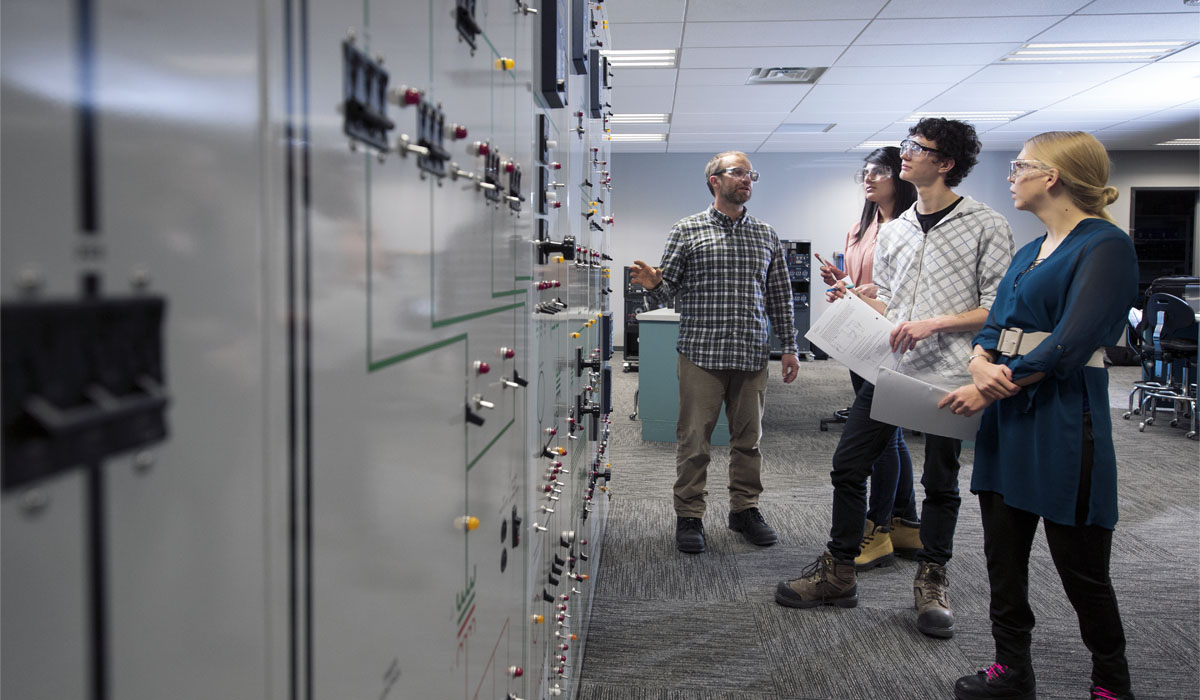Overview
Looking to take the next step in your power engineering career? If you already have a Third Class Power Engineering Certificate of Competency, this is the next step toward senior roles in the industry.
Approved by Alberta Boilers Safety Association (ABSA), SAIT’s Second Class Power Engineering Certificate of Achievement program gives you the technical knowledge to advance your skills in power plant operations, troubleshooting, and leadership.
Learn part-time, online, with instructor support—on your schedule. Take all six courses in the program to challenge six ABSA Second Class certification exams and get partial credit up to nine months toward ABSA work experience requirements.
Whether you're working toward certification or deepening your technical expertise, this program will set you up for success in Alberta’s power engineering sector.
This program is ideal if you:
- want to strengthen your knowledge and skills for ABSA’s Second Class Power Engineering certification exams
- need a flexible, structured approach to gaining advanced expertise in power plant operations
- are aiming for leadership roles in industrial plants, refineries, or power generation facilities.
To be successful in this program, we recommend you have:
- A minimum 50% in High School Grade 12 Math, English, Physics
- If you haven’t taken these courses or would like to refresh/upgrade your knowledge, consider taking a SAIT Academic Upgrading course equivalent.
You can enroll in this program with or without having a valid Third Class Power Engineering Certificate of Competency. However, to eventually write the Second Class Power Engineering certification exams with ABSA (or your province/territory's regulatory authority) you must have documented proof of a valid Third Class Power Engineering Certificate of Competency.
We strongly recommend that you have completed the four Third Class technical theory courses with SAIT (PWEN 130, PWEN 131, PWEN, 138, and PWEN 139) or another ABSA-recognized educational institute before taking this Second Class Power Engineering technical theory program.
By completing this certificate, you'll be ready to step into roles like:
Upon successful completion of this certificate, you’ll be able to:
- explain and apply ASME code calculations, boiler and pressure vessel legislation, and plant design standards
- demonstrate knowledge of management, supervision, maintenance programs, and safety protocols in industrial settings
- perform calculations related to motion, forces, thermodynamics, fluid dynamics, and fuels and combustion
- explain the theory, design, operation, and maintenance of steam turbines, internal combustion engines, and gas turbines
- interpret and prepare technical drawings, including mechanical, P&ID, PFD, and isometric diagrams
- describe the design, operation, and control of power plant systems, including fuel, water, steam, and combustion systems
- explain the principles and applications of electrical systems, including DC machines, AC motors, generators, transformers, and system protection
- describe piping systems, lubrication programs, bearings, and their applications in industrial equipment
- explain the composition, properties, testing, and corrosion control of metals, as well as welding principles
- describe the operation, maintenance, and safety requirements of boilers, pumps, compressors, and refrigeration systems
- demonstrate knowledge of water treatment processes, including pre-treatment, softening, demineralization, and internal treatment for boiler and non-boiler applications
- explain environmental monitoring methods and describe strategies for emissions control and sustainability in power plant operations
- apply fundamental industrial communication skills for effective workplace interaction and technical documentation.
Program outline
To successfully complete this certificate, you are required to complete a total of six courses.
Required courses & electives
How to apply for this certificate
Once you have registered for any course offered in this certificate, you will be automatically eligible to complete the certificate. You will have up to three years to complete this program. You may track your progression by signing in to your Continuing Education student account.
Certifications and professional designations
Upon successful completion of all the required courses in this certificate program, you’ll receive an electronically issued SAIT Certificate of Achievement and transcript.
SAIT will also provide an official result letter for each of the six courses completed, which you can submit with your application to write the ABSA Second Class A1, B1, A2, B2, A3, and B3 certification exams.
Note: To receive the ABSA Second Class Certificate of Competency (license to work as a Second Class Power Engineer), proof of work experience is also required. If you complete all six courses and work in an eligible role at a qualifying power plant as defined by ABSA, you may receive nine months' credit toward the 24-month operating/steam time experience requirement. For details on how this applies to your specific situation, contact ABSA directly.
Power Engineering certification requirements and transfer provisions vary by province and territory across Canada. Check with the regulatory authority in your desired work location for details:
- Want to work in Alberta? Contact ABSA.
- Want to work in another Canadian jurisdiction? Reach out to the local boiler branch in your new jurisdiction.
Costs
This program consists of six mandatory courses with varying fees. Fees include access to all course-related materials and resources found in Brightspace (D2L).
Please review the individual course pages for this certificate to determine costs and to learn more about additional learning materials including textbooks.
Financial support
Financial opportunities are available to help pay for your course fees. Learn more about how to reduce your education or training costs with available awards, bursaries, loans and grants including the Canada Alberta Productivity Grant.
Careers and opportunities
Skills learned in this program can be applied to a variety of supervisory and management careers. Expect to start at the entry-level and as you gain experience and with additional education, your career opportunities will expand.

Oki, Âba wathtech, Danit'ada, Tawnshi, Hello.
SAIT is located on the traditional territories of the Niitsitapi (Blackfoot) and the people of Treaty 7 which includes the Siksika, the Piikani, the Kainai, the Tsuut’ina and the Îyârhe Nakoda of Bearspaw, Chiniki and Goodstoney.
We are situated in an area the Blackfoot tribes traditionally called Moh’kinsstis, where the Bow River meets the Elbow River. We now call it the city of Calgary, which is also home to the Métis Nation of Alberta.


